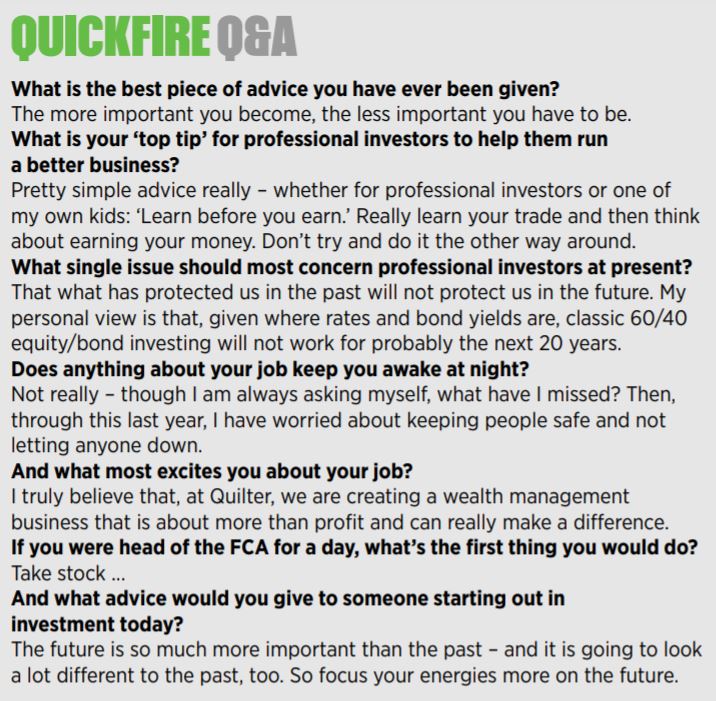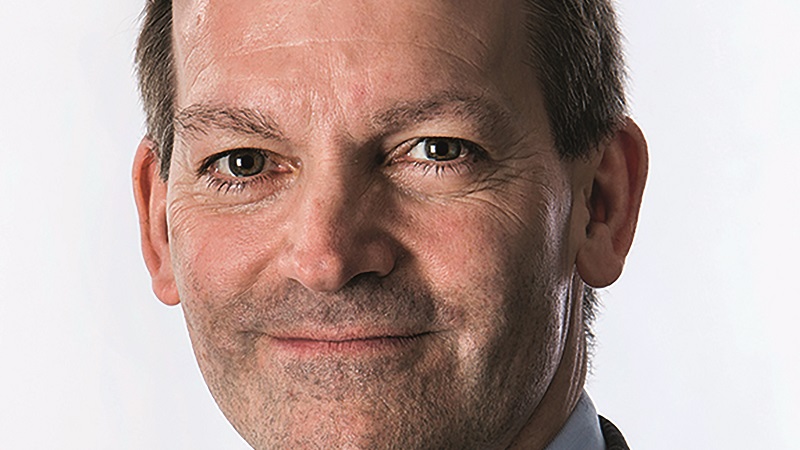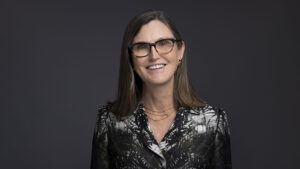Asset management groups have a big problem with how they present themselves to the outside world, argues Paul Feeney – an ironic state of affairs, given his equally firm belief they should be presenting themselves as solvers of problems.
“Real people don’t wake up in the morning thinking, what I really need is a multi-asset fund or a platform or whatever,” says Quilter’s chief executive officer. “Real people have problems they worry about and they need solutions to those problems. The trouble with asset managers is we present far too much as a fragmented, product-based industry where everyone is trying to eat each other’s lunch – forgetting the lunch actually belongs to the client. The more this industry can present itself as a provider of solutions – the more we can put on a client’s plate, as it were – the better.”
Based on his 30 years in asset management, during which time his roles have included CEO of NatWest Private Bank, group managing director at Gartmore and global head of distribution at BNY Mellon Asset Management, before joining Quilter’s previous incarnation Old Mutual Wealth as CEO in August 2012, Feeney observes: “As an industry, we need to focus on the face we are presenting to real human beings.
“It is time to get closer to the customer, to understand them and to present ourselves as providers of solutions for their problems – be it having enough money to retire on, putting their kids through school, paying off the mortgage or whatever. We started Quilter with the single idea of ‘real solutions for real people’ and, at the end of the day, to do that, you need to create wealth, which has to start with a plan.
“So we knew we had to provide financial advice – and then you need to fulfil that plan as efficiently as possible. In the UK, that speaks to tax-efficient wrappers so you need a platform. The third element is good, diversified, value-for-money investment management – and to get off the old hobbyhorse of active versus passive. That is irrelevant at the end of the day. You should be using both, depending on where you can and can’t find alpha.”
Death of diversification
To that end, since 2018 – the year it floated on the London Stock Exchange and sold off single-strategy business Old Mutual (later Merian) Global Investors to private equity firm TA Associates and an internal management team – Quilter’s focus has been firmly on running multi-asset portfolios. Here, Feeney offers a characteristically strong view on the range of assets investors need to be considering.
“One of the biggest risks investors face is the death of diversification,” he argues. “The classic way of diversifying is to hold government bonds but now these are yielding nothing – in fact, at the long end, we are seeing negative yields. We will look back in 10 years – maybe five – and ask, why didn’t we see something so obvious? It’s because this industry has become institutionalised about to how to diversify and reduce risk.
“Really, how much risk reduction will developed market government bonds give our portfolios going forward? Say you are charging 75 basis points and the bonds are yielding minus 10 basis points, well, you will get your money back in 10 years’ time – if you hold them till then. In the meantime, though, it is going to cost you 85 basis points a year – each year – over those 10 years, just to get your money back.
“And where can interest rates go? People are talking about negative rates – and that could happen – but, if you have effectively rates at zero, isn’t it more likely they will go up in time? People will look back on this period and ask, why did we still stick to the 60/40 portfolio principle? It may just be that 70/30 becomes the new 60/40 although, within the 30%, you need to look at what will give you suitable diversification.”
Alternative assets have an important part to play here, Feeney believes – though he cautions that investors will need to be clear about what they are buying. “Saying ‘alternatives’ is like saying ‘equities’,” he says. “One equity versus another can be completely different. Still, whether it is infrastructure, private equity, renewable energy, more absolute return-type vehicles and so on – there is a plethora of choice.
“The government has set up a working group to look at infrastructure and real assets investing in the UK, and a huge amount of public money will be going into that area. At the same time, the huge amount of public money that has gone into the bond markets will start unwinding. Maybe not this year or next but, if they are taking a longer-term view, investors will have to look at these asset classes for diversification from equities.”
Defining value for money
Having touched briefly on the cost of investing, how would Feeney define ‘value for money’? “First of all, value for money is not necessarily the same as lowest-cost,” he replies. “It can mean lowest-cost but, at the end of the day, value for money also involves achieving your objectives, a fair deal and peace of mind. Using myself as an example, I have a financial adviser from Quilter and an investment manager from Quilter Cheviot.
“I have been 30-odd years in investment management so I could probably have a go myself. To do that, however, I would need three things. I would need to think I have the capability – not any actual capability, just the belief I have it – I would need to have the time and I would need to have the inclination. Well, I have no inclination, no time and probably less capability than I think.
“So it gives me peace of mind to know people are looking after me and planning on my behalf. It works out at a higher price than me simply buying a tracker fund, say, but that is value for money. So asset managers do need to be a bit more sophisticated, which is where I come back again to solutions. If all you have is a hammer, everything will look like a nail – and if all you think about is product, the only thing you will focus on is price.
“If you think in terms of solutions, however, you can ask yourself, what are we doing to solve the real problems real people face? The regulator has done some very good work to focus the industry’s mind on value for money and we have seen some big names admit a number of their funds do not provide it. It should not have taken the intervention of the regulator to achieve that, of course, but it did.”
Advising the regulator
Feeney recently took over from Zurich UK CEO Tulsi Naidu as chair of the Financial Conduct Authority’s independent Practitioner Panel, of which he has been a member since 2015. What sort of role does the panel play in the regulation of the asset management sector?
“Obviously we are not the regulator – we are an advisory panel to the regulator – but I think it has a hugely important role,” Feeney says. “We do not exist to beat the regulator up or to be its supplicants but to be a critical friend. The expertise on the panel is tremendous – we have CEOs from some of the largest firms, right across financial services – and we are there, first, to advise the regulator on what we perceive the consequences will be of actions it wishes to take and, second, to offer advice – maybe even guidance – on where we think intervention needs to happen.
“When Tulsi was chair, she did a fabulous job of co-ordinating the panel to help the regulator act decisively on things the industry knew would help end-consumers – for example, if everyone is at home in a pandemic, it is not so easy to obtain a ‘wet’ signature, so let’s just make everything digital. And, bang, that happened within such a short period of time.
“Then there was dispensing with the 10% rule for a period of time. The rule may have seemed a good idea when it was first thought of but then, unfortunately, the real world hits and the worst thing people could have done last year was sell when all those letters went out last March. At Quilter, we have been able hold our clients’ hands through all this but a lot of investors were thinking, should I sell up? That would have been completely wrong.
“It is easy to whip the regulator but, fundamentally, it has reached a balance between protecting investors and allowing asset managers to do the best job they can. There are things the industry should have worked out itself but didn’t. And then look at how quickly the regulator acted during this pandemic to help the industry, which ultimately helps consumers. Things that would have taken a year or two to get done happened in weeks.”
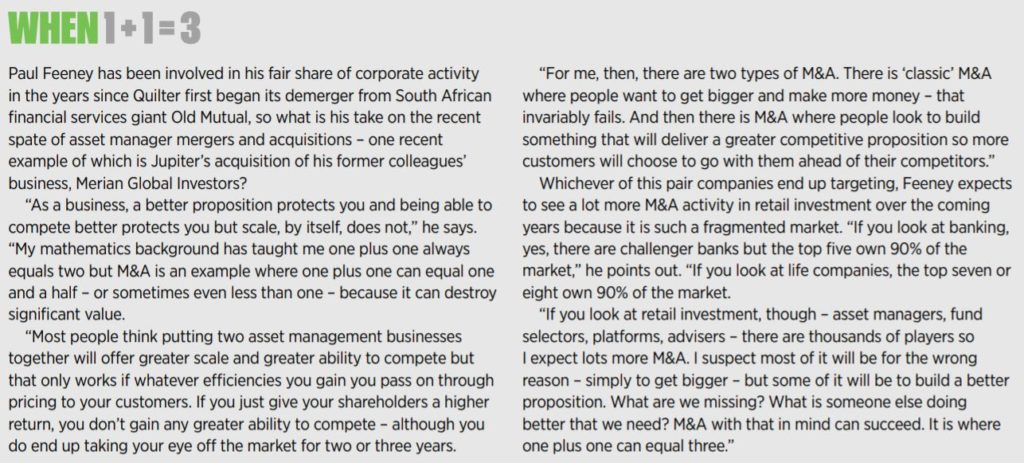
Defining Quilter’s brand and culture
The stockbroking roots of the Quilter name can be traced all the way back to 1771 but what sort of culture and brand values were Feeney and his colleagues looking to convey after the Old Mutual demerger?
“We spent a long time – a few years – imagining what type of company we wanted Quilter to be before building that company,” he replies. “Building a brand, however, comes down to who you are, not what you are.
“So now we are spending a lot of time imagining who we want to be. We know people have problems that need solving and, if they do not reach out, it is because they don’t know who to trust. In our industry, we do not provide a tangible product. You cannot smell it, you cannot taste it, you cannot ride it, you cannot touch it – and yet you have to believe it will work for you. So the most important ingredient for a brand in our industry is trust.
“A couple of months after I started here, the then group chief executive asked me what I had found that I thought I could use. I told him, people care – and I could harness that because people will only trust you when they experience what you do. For me, then, it all starts with how we treat our own people – and it is why we have put so much effort into our Thrive programme and mental health support.
“You won’t find them in any of our audited accounts or strategy documents but, when we listed this company, I set myself three goals. The first was to create an environment where our people can thrive, where it is OK not to be OK, where they can bring their authentic selves to work, where they are welcomed and where they then have equal opportunity.
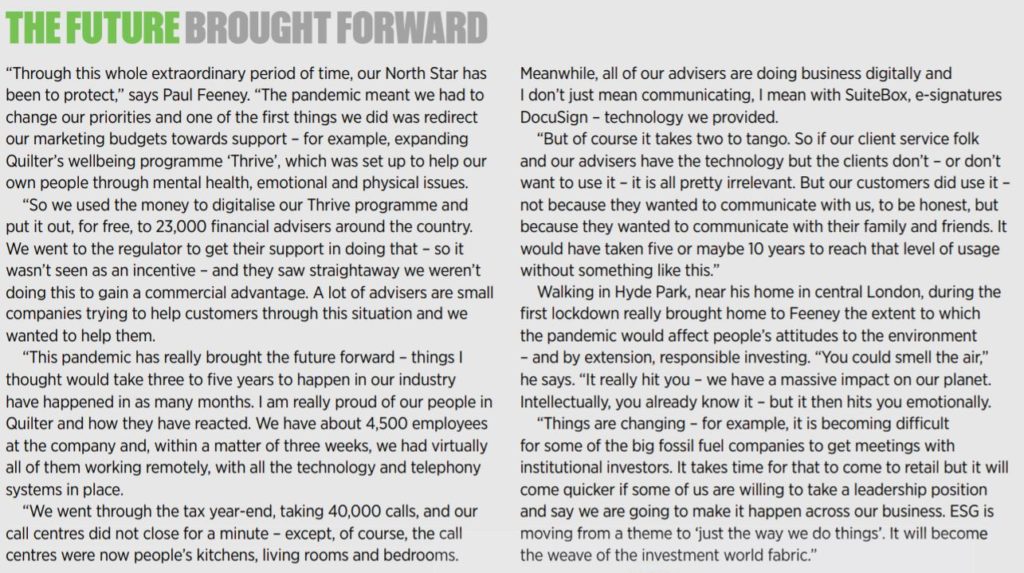
“The second goal was to create ‘the ties that bind us’ – so we feel a common purpose. We set up the Quilter Foundation to try and help those less fortunate than we are. So while Quilter’s purpose is to help people prosper, the foundation’s purpose is the other side of the coin – to help overcome the barriers to prosperity that young people in our country face. We are building something that is about more than profit – it has to be like that.
“The third goal, as we have discussed, was to make this a solutions-based business so, when customers deal with us and they go from financial advice to platform to money management, it is simple, they feel valued and they gain peace of mind. Those were my three goals and a lot of it comes down to culture – an issue I expect to be the defining one for our industry over the next 10 years.”
